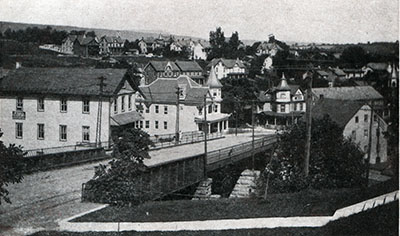At the turn of the twentieth century, a “new” Main Street bridge was built over Trout Creek. The “new” bridge replaced a wrought-iron, arch bridge (the Henszey bridge, named for its inventor, Joseph G. Henszey) that had been erected in March 1870.
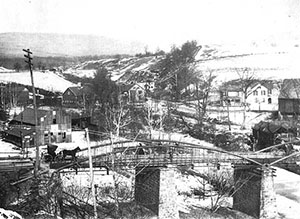
By the late 1890s, that Henszey bridge had outgrown its usefulness, and a new bridge across Trout Creek was needed. Below is a quick timeline of the approval process. (Note that this took place at the same time that a new bridge was being built for the South Walnut Street crossing of Trout Creek.).
- February 1900, the Slatington borough council agreed to petition Lehigh County for a new bridge.
- March 1900, the bridge petition was presented, and the county appointed viewers to examine the old bridge.
- June 1900, the viewers decided that the county should build a new bridge.
- July 1900, the judge of the Lehigh County court of four sessions agreed that a new bridge was necessary, as the old bridge was too dangerous. The court also determined that the county should build the bridge because it was too expensive a project for the borough to undertke. The county commissioners agreed with the judge's ruling.
- August 1900, it was decided that the new bridge would be of made of steel, 180 ft. long and 42 ft. wide with a 10 ft. sidewalk, 20 ft. road way and 12 ft. for trolley tracks. The borough council agreed to pay for excavation and fill on the west end of the bridge.
- 8 September 1900, contracts were awarded for the new bridge.
With everything in place by fall 1900, construction began.
The old, Henszey bridge was dismantled and removed to Ontelaunee Creek on the road from Kempton to New Tripoli in Lynn Township, and a temporary footbridge put in place over Trout Creek.
The total cost of the bridge was about $28,000. There were 2 masonry piers, east and west masonry abutments, and 3 steel spans over a total length of a little more than 210 feet. The bridge itself was a through steel girder, with buckle plate to support a concrete and Belgian block surface. The grade was a bit over 9%, and the bridge height reached about 28 feet over the Slatedale branch of the Lehigh Valley Railroad.
The contract for the excavation and masonry work ($12,000) went to Horn & Neff (Levi Horn of Weissport and O. A. Neff of Slatington); and the contract for the steel bridge superstructure ($16,000) was awarded to the Penn Bridge Co. of Beaver Falls, PA.
Progress on the bridge was quick. Masonry work proceed through the fall and into January 1901. By February, the last of the three 14-ton steel stringers (girders) for the first span across the Trout Creek were in place, and by June 1901, the bridge was open.
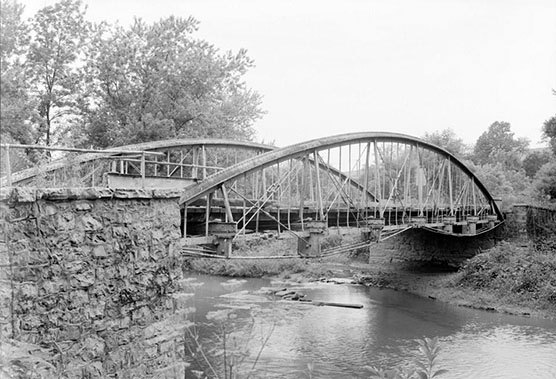
The Henszey bridge over Ontelaunee Creek
The bridge was repaired and updated in 1948 and 1977.
As early as 1990, the Pennsylvania Department of Transportation began considering replacement of the Main Street (State Route 873) bridge.
In 1999, the state described the scope of the proposed project:
the demolition of the Main Street Bridge which is a contributing element to the National Register-eligible West Main Street/Kern Historic District. The project will also require demolition of the Slatington News Company Building. The Slatington News Company Building not only contributes to the significance of the West Main Street/Kern Historic District but is also individually eligible for listing in the National Register of Historic Places. The project will also require the permanent acquisition of approximately 0.024-hectare (0.065 acre) from the 5.1-hectare (12.6 acre) Kern's Mill Park. In addition, a 0.01 hectare (0.022 acre) temporary construction easement will be required from Kern's Mill Park on the north side of the existing bridge and a 0.36 hectare (0.898 acre) temporary construction easement will be required from Kern's Mill Park on the south side of the existing bridge.
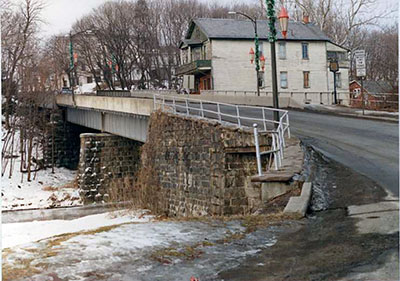
Slatington's Main Street Bridge circa the 1990s; Photo credit Pennsylvania Historical Resource Survey
There was found to be no practical alternative to the complete demolition of the bridge.
See the information on the Slatington News building for an account of the demolition of the bridge and the construction of the replacement bridge.
I walked that bridge hundreds of times. Before 1977, the sidewalk was lined with wood planking and a bit creaky. After the 1977 work on the bridge, there was a concrete barrier between the road and the sidewalk.
You had to walk the bridge to get between upper and lower Slatington, and you had to walk the bridge if you were going up to the new high school or coming home from the new high school. Because of the grade, it was much easier walking down the bridge than it was walking up the bridge! I also walked the bridge if I was going fishing up at the Skeet Club or going to Boy Scouts at the old pioneer lodge on what was then called the “old road.”

circa 1920s view; photo credit Slatington at 150 Years: More Stories to Share (2014), p. 51
Troop #1 (aka #65) began work on the scout house in 1922 and built it log by log. It was an amazing structure that is, unfortunately, no longer with us. Now that "old road" is called the Scout House Road, but there is no scout house there.
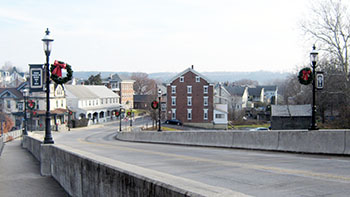
Current view of the bridge, circa 1923
